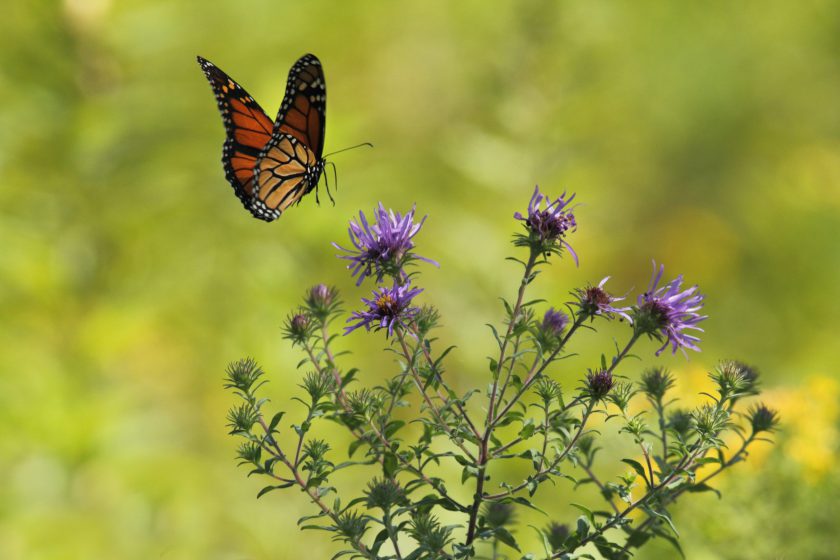From the diurnal group of the biological family of insects including the moth, the adult butterfly is traditionally viewed as possessing brightly colorful wings and an unmistakable irregular beat during flight.
Occasionally butterflies such as the Monarch have been known to migrate for vast distances becoming agents of the pollination process transporting pollen to aid in the preservation and reproduction of a number of plant species. In other instances butterflies have been regarded as pests due to the imminent damage caused to domestic crops and trees during their larval stage.
Facts about the butterfly
- It is thought that the butterfly derived its name from the Middle English dialect of the word butterflies or from the combination of the two words butor which means beater and fleoge which when translated means, fly.
- To date, the earliest discovery of butterfly fossils is documented as being more than fifty million years old.
- The adult butterfly can live from a week with some species even living up to twelve months remaining asleep in their pupal stages during the winter months.
- A butterfly’s eggs are attached to a leaf with a unique fast acting adhesive. The eggs are preserved by a firm outer layer known as a chorion, covered with a sheer wax coating which acts as a method of preserving the moisture within the egg allowing the larva to fully develop.
- Butterflies are distinguished by minute scales covering their wings responsible for giving the various species their distinctive colors. These scales dyed with a type of natural organic pigment create the black and brown color we often see in the wings. Other colors such as red, blue, and green are created by the microstructure of these scales resulting in the dispersing of light rays as they are reflected by the scales.
- The mature adult butterfly is known for having four wings consisting of both a forewing and hindwing on both sides of its body.
- The butterfly is known for primarily feeding on the nectar of flowers. There are some species however which have been additionally observed as obtaining their food nutrient from decaying flash, rotting fruit, tree sap, pollen and even feces.
- Some butterfly species dependent on a rich sodium nutrition are attracted to the salt contained within human sweat, often landing on individuals running or jogging in the park.
- A butterfly’s antennae is vastly covered with several sensory organs referred to as sensillae used to detect any scents within the air.
- The butterfly exhibits a sense of taste more than two hundred times stronger than the average adult human being.
- Some species of the butterfly are known for having organs allowing them to hear audible sounds which can be observed in some strains of the insect rubbing together certain body parts to produce specific sounds and clicks for communicating.
The Florida Museum of Natural History
Live Critter Cams featuring the Butterfly
Recognized as one of the largest and quickly developing natural history museums within the United States of America, the Florida Museum of Natural History’s Butterfly Rainforest gallery in a joint effort with the University of Florida has added three live streaming webcams to their exhibit allowing visitors a chance to view the exhibit from any location worldwide.
The First webcam or Chrysalis Cam allows viewers the opportunity to see a wide variety of butterflies and moths imported from several butterfly farms worldwide, coming out from their cocoons. The pupae upon arrival are unpacked and categorized accordingly after which they are placed on exhibition in front of a number of window cases. A secondary camera or Feeding Station Cam features a fruit tray used for feeding the butterflies with nectar from flowers as well as providing the juices from rotting fruit. The third webcam or Canopy Cam is positioned thirty feet above ground giving viewers a breathtaking bird’s-eye view of the rainforest filled with luxurious tropical vegetation, rapids waterfalls and a vast number of butterflies and rare tropical birds in a natural habitat.
View The Florida Museum of Natural History webcam.
The Monarch Monocle Webcam
Recognized as one of the natural wonders of the Earth the Monarch butterfly each year have been observed during the summer months migrating from Mexico to Canada laying millions of eggs along their route.
The Monarch Monocle Webcam broadcasts a live stream featuring the lifecycle of the North American Monarch Butterfly beginning with its egg right up to its butterfly stage. Currently the species is in the caterpillar stage of their life.
View The Monarch Monocle webcam.
The Stanley Hotel Butterfly Webcam
Located in Estes Park in the state of Colorado, the Stanley Hotel, less than six miles from the Rocky Mountain National Park is renown for it’s vintage appeal, magnificent view and spectacular architecture.
The hotel in collaboration with the Estes Park High School students features a live webcam exhibit from its butterfly tank used in the education of its guests on the current decline in the butterfly population and the importance to improve the country’s population. The display consists of both the species of the Painted Ladies and the Monarch butterflies allowing viewers an in-depth and detailed look at their evolution process from caterpillars to hatching from their chrysalis stage to butterfly.
View The Stanley Hotel Butterfly webcam.
The Key West Butterfly and Nature Conservatory
Located in Key West, Florida, the Key West Butterfly and Nature Conservatory provides a memorable attraction for children, adults and the entire family. The facility is famous for its impressive and breathtaking selection of cascading waterfalls, tropical birds, exotic flowers and over sixty butterfly species collected from all over the world displayed in a climate-controlled glass environment.
Visitors to their website can view a number of uploaded videos and photos provided by the conservatory and some of the guests by clicking on the link below:
View The Key West Butterfly and Nature Conservatory webcam.

